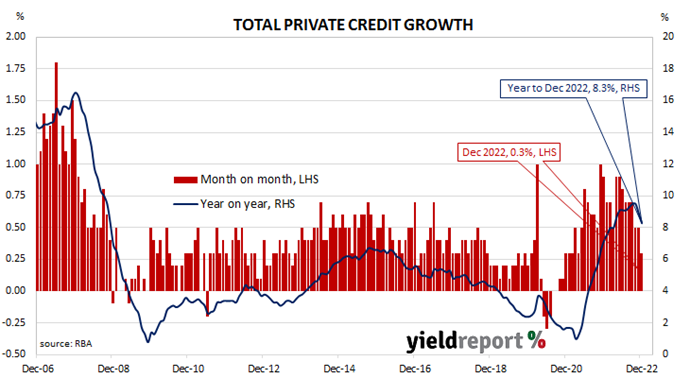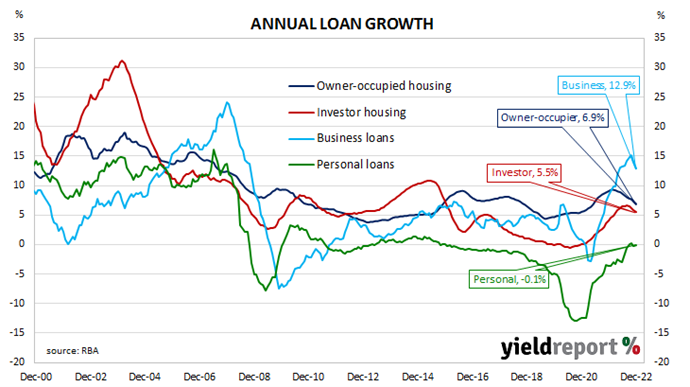Summary: Private sector credit up 0.6% in December, in line with expectations; annual growth rate up from 9.4% to 9.5%; new lending for housing now declining; business loans account for 50% of net growth.
The pace of lending to the non-bank private sector by financial institutions in Australia followed a steady-but-gradual downtrend from late-2015 through to early 2020 before hitting what appears to be a nadir in March 2021. That downtrend ended later in the same year and annual growth rates are above the peak seen in the previous decade.
According to the latest RBA figures, private sector credit increased by 0.3% in December. The result was less than the 0.5% increase which had been generally expected as well as November’s 0.5% rise. On an annual basis, the growth rate slowed from 8.9% to 8.3%.
“The December private sector credit update provided further confirmation of the well-established slowdown in credit growth,” said Westpac economist Ryan Wells. “The interest-rate-sensitive housing sector continues to lead the down-trend, although business credit, which expanded at a strong pace over last year, is also easing notably.”
Shorter-term Commonwealth Government bond yields moved a touch lower on the day while longer-term yields moved modestly higher. By the close of business, the 3-year ACGB yield had slipped 1bp to 3.19%, the 10-year yield had added 2bps to 3.56% while the 20-year yield finished 3bps higher at 3.95%.
In the cash futures market, expectations regarding future rate rises softened slightly. At the end of the day, contracts implied the cash rate would rise from the current rate of 3.07% to average 3.24% in February and then increase to an average of 3.65% in May. August 2023 contracts implied a 3.75% average cash rate while November 2023 contracts implied 3.72%.
“We downgraded our credit growth forecasts, reflecting a decline in risk appetite as a result of weaker expectations of economic growth, inflation and rising interest rates,” said ANZ senior economist Adelaide Timbrell. “We expect total credit growth to slow from 9.0% year-on-year in Q4 2022 to 4.3% year-on-year in Q4 2023.”
Owner-occupier lending accounted for just under 50% of the net growth over the month. Business lending accounted for a little over a third and investor lending accounted for a little under 20%. Personal lending contracted a touch.
The traditional driver of overall loan growth, the owner-occupier segment, grew by 0.4% over the month, the same growth rate as in November. The sector’s 12-month growth rate slowed again, this time from 7.3% to 6.9%.
Total lending in the business sector increased by 0.3%, down from the 0.7% increase recorded in November. Growth on an annual basis slowed from 14.0% to 12.9%.
Monthly growth in the investor-lending segment slowed to a near-halt in early 2018 and essentially stayed that way until mid-2021. In December, net lending grew by 0.3%, the same rate as in November, October and September. The 12-month growth rate slowed from 5.9% to 5.5%.
Total personal loans contracted by 0.5%, in contrast to November’s +0.1%, taking the annual contraction rate from 0.2% to 0.1%. This category of debt includes fixed-term loans for large personal expenditures, credit cards and other revolving credit facilities.



